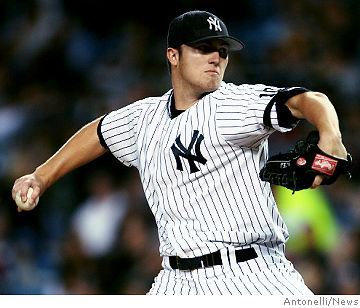The Phil Hughes 15 minutes of Fame

The scene in Moneyball that highlights the failures of its main character, Oakland A’s general manager Billy Beane, in performing at the Major League level still gets me. I genuinely have trouble watching it. Watching failure is hard. The sports industry spends a lot of time ridiculing those that aren’t the very best at what they do. It’s understandable — we tend to get caught up in our responsibilities — and usually not personal for critics to critique harshly. But the Moneyball scene captures the other end of that. There’s someone with their own feelings, and dreams, being talked about as a failure.
Growing up in the metropolitan area, and paying attention to the trends that run through it, one player that I recall being routinely lambasted by criticism was Phil Hughes. We roasted him in 2016.The pitcher was drafted with the 23rd overall pick by the New York Yankees back in 2004 and carried high expectations thereafter. He was somewhat successful initially, being named an all-star in 2010, but not unlike another buzzworthy Yankee of that period — Lord Joba Chamberlain, may god have mercy on his bug-ravaged soul — everything came crashing down. As the great american philosopher, me, once said “It’s okay to be wrong.” The same goes for major league prospects.
The hype all but evaporated into full-fledged. He became the butt of many twitter roasts, himself even referencing as much, and failed to live up to the lofty expectations and was cast off to the Minnesota Twins three seasons after his all-star appearance.
There is broad belief – if not an outright law – that performing in New York is different than other places. Do the numbers necessarily support this? Probably not. Is that narrative just an indirect way for New Yorkers to attach more of an importance, and value, to their city? Probably, yes!
But in the case of Phil Hughes, such a theory might’ve been true. Because despite all the empirical evidence we’d received beforehand, Hughes’ first season in Minnesota — which, from what I gather, is definitely not New York — was exemplary.
In 32 starts across a total of 209.2 innings, Hughes finished the season with an ERA of 3.52, a WHIP of 1.13, and 186 strikeouts. But more importantly, he finished 7th in CY Young voting and, in what can only be described as a Sixth Sense-level plot twist, broke the all-time MLB record for best strikeout-to-walk ratio (11.63!) in a single season that was previously held by Bret Saberhagen in 1994. It’s on the shortlist for the most surprising baseball breakouts of the last decade.
One of the key reasonings for the breakout, as discussed in this piece from Beyond the Box score, was his mechanical changes. They were fairly drastic changes – not just something as simple as an uptick in velocity. Hughes reworked practically his entire pitching repertoire, abandoning his curveball and offspeed usage almost entirely in favor of an improved two-seam fastball and cutter. Evidently, those changes resulted in a literally historic season.
If the old saying about each person having their own 15 minutes of fame is true, then 2014 was that for Phil Hughes. It’s not a story of simply just being better, but a story of a true turnaround. A new city and a new beginning — leaving the past behind you, some might say — resulted in a truly extraordinary rebirth. While pitching even a single inning in Major League Baseball is cause for celebration, in the context of what Hughes had previously endured, the 2014 success serves as an allegory for the American dream.
Not everyone grows up to be a movie god or a rockstar. In the case of Phil Hughes, not everyone becomes Clayton Kershaw (who ended up breaking Hughes’ record in 2016 when he struck out 15.64 per walk). Hughes may have only had this stretch of success for a brief period — almost as if the baseball gods, in the vain of Andrew Shephard in the American President, had decried “Sorry, but your 15 minutes are up!” — but that, in a sense, almost made that much more profound. Success, for most, is an ever-so elusive damsel, and a fleeting one at that. aybe it’s more beautiful because it doesn’t last.
Nowadays Hughes is part of another phenomenon: a crew of somewhat average pitchers that ended up, near inexplicably, being the best twitter personalities for the sport (e.g. Sean Doolittle, Dan Haren, Brandon McCarthy). Plus, he’s got his own side hobby in the form of a YouTube channel dedicated to owning baseball cards.
There’s something uniquely admirable about his arc. Hughes had a dream, failed in pursuit of that dream in the bright lights, before having a brief and yet lasting moment (year?), to engaging in a rather laid back hobby, and being heartwarmingly (heartbreakingly?) human throughout it all. Maybe there’s something we should all learn from him.
















